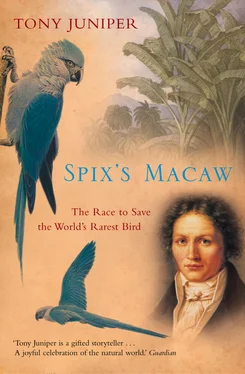In the nest the three eggs lay smashed. The two trappers had reached inside for young birds in the hope that they could take baby macaws too; they would fetch an even better price than the sleek adult bird. They were too early for that, however, and their clumsy groping in the dark broke the fragile white shells and spilled the contents into the base of the hollow. The blood-streaked yolks slowly congealed in the wood shavings at the bottom of the nest chamber. Disappointed not to find chicks, the trappers were pleased that they at least had caught one of the adult macaws before someone else did. It was Christmas Eve 1987. The capture of the blue parrot would certainly brighten the trappers’ festivities.
The macaw soon found herself in a crate ready for loading into the back of the four-wheel-drive vehicle. It was now daylight and the men prepared for departure along the long dusty track that led back the main tarmac road. Just before leaving, they saw a man approaching on foot. He approached and then stopped to ask what they were doing.
The stranger seemed harmless enough, certainly not a policeman, so the trappers boasted about the valuable creature they had taken that morning. The man asked to see it. The chief trapper opened the rear door of the jeep and pulled an old blanket to one side revealing the blue bird in its crate. It recoiled at the sudden bright light and shrank back into the shadows. The man was impressed, he asked if he might take a photo of the gorgeous blue creature. After the trapper had shrugged his consent, the man took a Polaroid camera from his green bag, carefully composed his picture and pressed the shutter. He waited a few moments then peeled back the paper backing from the print to reveal the image of the caged parrot.
He did not know it, but the image that was gradually appearing on the Polaroid as it dried in the warm morning air was of the last wild female of the blue caatinga parrots. After her capture, only her partner remained. He was the last Spix.
On 3 June 1817, Dr Johan Baptist Ritter von Spix and his travelling companion and fellow scientist Dr Carl Friedrich Philip von Martius set sail for the Atlantic Ocean from Gibraltar. They had arrived in the bustling port some weeks previously from Trieste in the Adriatic. Along with fifty other vessels of various sizes their ship had waited for the right weather conditions for their voyage to South America. This day brought the easterly winds necessary to propel them from the Mediterranean Sea on the 6,000-kilometre voyage to the southern hemisphere and their destination, Rio de Janeiro, the capital of the Portuguese colony of Brazil.
The son of a Bavarian doctor, Spix was born in 1781. Awarded his PhD at the age of only nineteen, his early academic career included studies in theology, medicine and the natural sciences. He qualified as a medical doctor in 1806. In 1808 he was awarded a scholarship by King Maximilian Joseph of Bavaria to study zoology in Paris, at the time the world’s leading natural sciences centre. Here the young Bavarian mixed with the leading biologists and naturalists of the time, including the French biologist Jean-Baptiste Lamarck, the intellectual giant who proposed a mechanism of evolution that would challenge (unsuccessfully as it turned out) the theory of natural selection developed some decades later by Charles Darwin.
In Paris, Spix’s abilities as a scientist grew; in October 1810 the King once again acknowledged his growing reputation, this time with an appointment in the Bavarian Royal Academy of Sciences where he was charged with the care and study of the natural history exhibits. Martius was a gifted academic too. Thirteen years younger than Spix, his interests were mainly botanical, especially palms.
The two scientists found themselves aboard one of two Brazil-bound ships as members of an expedition mounted in the name of the Emperor Francis I of Austria, whose daughter was to marry the son of John VI of Portugal. King John had been forced to live in Brazil following the invasion of his homeland in 1807 by Napoleon Bonaparte of France. The Austrian Emperor had invited a group of Viennese scientists to join the royal party that was to travel to Brazil. Maximilian had agreed that two members of the Bavarian Academy of Sciences should go with them.
Spix was to concentrate his effort on animals, the local people and geological recording, including the collection of fossils. Martius was to devote his energies to botanical investigation, including soil types and the study of how plants spread to new lands. The King was a bird collector in his own right and hoped that the two men would bring him novel and unique prizes from their expedition in the New World. ‘After everything possible was got ready, and the books, instruments, medicine chest, and other travelling equipage sent off direct to Trieste, we set out from Munich on 6 February 1817, for Vienna.’ At Trieste they joined the ships, two naval frigates, the Augusta and the Austria . Both were substantial vessels equipped with forty-four guns and a crew of 240 sailors.
On 29 June they crossed the equator and on 13 July Cabo Frio was sighted, ‘and soon after the noble entrance of the bay of Rio de Janeiro’. 1 The arrival in South America made a big impression on the travellers.
Towards noon, approaching nearer and nearer to the enchanting prospect, we came up to those colossal rock portals and at length passed between them into a great amphitheatre, in which the mirror of the water appeared like a tranquil inland lake, and scattered flowery islands, bounded in the background by a woody chain of mountains, rose like a paradise full of luxuriance and magnificence … at length the capital of the infant kingdom, illuminated by the evening sun, lay extended before us.
A sensation, not to be described, overcome us all at the moment when the anchor struck the ground at another continent; and the thunder of the cannon, accompanied with military music hailed the desired goal of the happily accomplished voyage.
The travellers decided to spend some time initially in the relative cool and comfort of the south east of the country, first in Rio de Janeiro and then in São Paulo and Curitiba. Spix and Martius explained, ‘it seemed most expedient to journey first to the southern Captaincy of S. Paulo, mainly to acclimatise ourselves gradually to the hot conditions we would encounter during our travels and acquaint ourselves with this more temperate southern zone. From the Captaincy of S. Paulo we planned to travel through the interior of Minas Gerais to the S. Francisco River and Goyaz, before continuing either down the Tocantins to Pará or across the interior to Bahia and the coast, where we would arrange transport of our collections to Europe before penetrating the interior of the Captaincies of Piauhy and Maranhão to arrive finally at Pará, the goal of our desires.’
To a twenty-first-century traveller, such an itinerary would be demanding enough, entailing a journey of thousands of kilometres, mainly on rough tracks and by river. Although the Bavarians enjoyed the small luxury of letters of recommendation from the Portuguese – Brazilian Government that would help smooth their path with colonial administrators, they could carry only basic equipment, much of which was for scientific purposes rather than their personal comfort. They had incomplete maps, primitive medical supplies and could rely only on mule trails and rivers to cover the vast distances that lay ahead of them. In those times, natural history exploration was a hazardous business. Disease, attack from native people or wild animals, climbing and firearms accidents, starvation and even the use of dangerous chemicals for scientific purposes, like arsenic, all took their toll on the early naturalists.
Читать дальше












